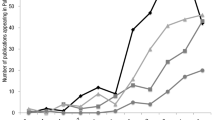Abstract
Accurate estimates of health risk factors and outcomes are difficult to obtain for certain ethnic populations. The health of Jewish individuals is particularly hard to determine because of the small group size and because health data rarely include information on religious affiliation. Furthermore, local level health information (for any population subgroup) is limited. To assess health risk factors and outcomes, as well as issues related to access to care, within a Jewish community in Chicago, a group of community agencies and researchers initiated a unique, population-based health survey. Specifically, a three-stage sampling design was used to select a representative sample of 201 adults and 58 children in the most concentrated Jewish neighborhood in the city. Nearly 500 questions were asked, covering a wide variety of demographic, socioeconomic, and health-related topics. The findings revealed that these Jewish individuals were generally as healthy (or healthier) than the average residents of Chicago and the U.S.; however, many serious health concerns still existed. In particular, health problems such as obesity, depression, disability, and domestic violence were common and, in some cases, more prevalent than in the general population. This local level information provides the first accurate estimates of key health variables for the estimated 23,000 Jewish individuals living in this community. This type of data is essential because it enables the efforts and priorities of health and social service providers to be focused on the most pressing health problems. Moreover, this project provides an example for other population subgroups (based on residence, ethnicity, religious affiliation, country of origin, or other characteristics) who would benefit from local level health information.

Similar content being viewed by others
Notes
Sources: Jewish Community Health Survey 2003 and NHANES, 1999–2000. Note: NHANES data is for children 2–11 years of age.
References
Fielding JE, Frieden TR (2004) Local knowledge to enable local action. Am J Prev Med 27: 183–184
Shah AM, Whitman S, Silva A. Geographical variation in the health of six Chicago community areas: A case for local level data. Am J Public Health 2006; 96(8):1485–1491
Jacobs LA, Giarelli E (2001) Jewish culture, health belief systems, and genetic risk for cancer. Nursing Forum 36: 5–13
Kennedy GJ, Kelman HR, Thomas C, Chen J (1996) The relation of religious preference and practice to depressive symptoms among 1,855 older adults. J Geron 51B: P301–308
Levav I, Kohn R, Golding JM, Weissmen MW (1997) Vulnerability of Jews to affective disorders. Am J Psych 154: 941–947
Egan KM, Newcomb PA, Longnecker MP, Trentham-Dietz A, Baron JA, Trichopoulos D, Stampfer MJ, Willett WC (1996) Jewish religion and risk of breast cancer. Lancet 347:1645–1646
Koenig HG, McCullough ME, Larson DB (2001) The Handbook of Religion and Health. Oxford University Press, Oxford
Jewish Federation of Metropolitan Chicago. Results of the Jewish Federation of Metropolitan Chicago’s 2000–2001 Population Study. Unpublished Report. 2002
Whitman S, Williams C, Shah AM. Sinai Health System’s Improving Community Health Survey: Report 1. Chicago, Illinois: Sinai Health System, 2004
Survey Research Laboratory. 2004. Community Health Survey of West Rogers Park: Final Methodological Report. University of Illinois at Chicago, Survey Research Laboratory, Project #951
Centers for Disease Control and Prevention (CDC). 2005. Clinical Growth Charts. Retrieved from: http://www.cdc.gov/nchs/about/major/nhanes/growthcharts/clinical_charts.htm.Retrieved on: October 20, 2005.
Radloff LS (1977) The CES-D scale: A self-report depression scale for research in the general population. Appl Psych Meas 1:385–401
SAS Institute Inc (2004) SAS 9.1.3 Help and Documentation. SAS Institute Inc, Cary, NC
National Jewish Population Survey 2000–01: Strength, Challenge and Diversity in the American Jewish Population. A United Jewish Communities Report, in Cooperation with the Mandell L. Berman Institute and the North American Jewish Data Bank. January 2004
Abid O, Galuska D, Kettel Khan L, Gillespie C, Ford ES, Serdula MK. Are healthcare professionals advising obese patients to lose weight? A trend analysis. Medscape General Medicine 2005; Oct. 10, 2005.
U.S. Preventive Services Task Force (2003) Behavioral counseling in primary care to promote a healthy diet: Recommendations and rationale. Am J Prev Med 24: 93–100
Kessler RC, Berglund P, Demler O, Jin R, Koretz D, Merikangas KR, Rush AJ, Walkers EE, Wang PS (2003) The epidemiology of major depressive disorders: Results from the National Comorbidity Survey Replication (NCS-R). JAMA 289: 3095–3105
Centers for Disease Control and Prevention (CDC). Behavioral Risk Factor Surveillance System Survey Data. Atlanta, Georgia: U.S. Department of Health and Human Services, Centers for Disease Control and Prevention, 2003
U.S. Department of Health and Human Services. 2005. The HHS Federal Poverty Guidelines. Retrieved from: http://aspe.hhs.gov/poverty/03poverty.htm. Retrieved on: November 10, 2005
Fang J, Bosworth W, Madhavan SH, Cohen H, Alderman MH (1995) Differential mortality in New York City (1988–1992). Bull NY Acad Med 72:483–99
Acknowledgments
The project described in this paper was supported by generous grants from the following foundations: Polk Bros. Foundation, Jewish Federation’s Fund for Innovation in Health (supported by the Michael Reese Health Trust), Irvin and Ruth Swartzberg Foundation, and the Fel-Pro Mecklenberger Supporting Fund.
Author information
Authors and Affiliations
Corresponding author
Additional information
Maureen R. Benjamins, PhD is an Epidemiologist and Steven Whitman, PhD is the Director of the Sinai Urban Health Institute, Mt. Sinai Hospital, 1500 S. California Ave., Chicago, IL 60608, USA. Dana M. Rhodes, MSW is the Director of Grants and Community Service and Joel M. Carp, ACSW is the Senior Vice President Emeritus for the Jewish Federation of Metropolitan Chicago, 30 S. Wells St., Chicago, IL 60601, USA.
Rights and permissions
About this article
Cite this article
Benjamins, M.R., Rhodes, D.M., Carp, J.M. et al. A Local Community Health Survey: Findings From A Population-Based Survey Of The Largest Jewish Community In Chicago. J Community Health 31, 479–495 (2006). https://doi.org/10.1007/s10900-006-9025-5
Published:
Issue Date:
DOI: https://doi.org/10.1007/s10900-006-9025-5




